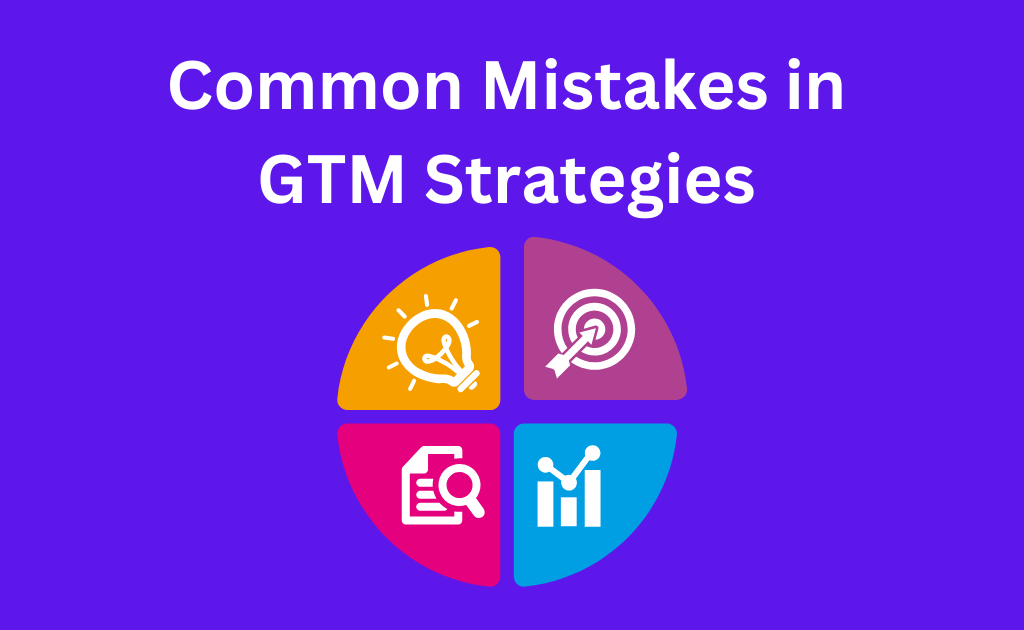Introduction
Launching a product or service into the market is no small feat. A well-crafted Go-To-Market (GTM) strategy can mean the difference between a blockbuster success and a costly flop. But here’s the catch: even the most innovative products can stumble if the GTM plan falls short. Businesses pour time, money, and energy into their offerings, only to see them falter due to avoidable missteps. The good news? These pitfalls are predictable—and preventable.
In this blog, we’ll dive into the most common mistakes companies make in their GTM strategies and share practical tips to sidestep them. Whether you’re a startup founder, a marketing pro, or a product manager, this guide will help you refine your approach and set your launch up for success. Let’s get started.
Table of Contents
What Is a GTM Strategy, and Why Does It Matter?

Before we jump into the mistakes, let’s clarify what a GTM strategies is. Simply put, it’s your roadmap for bringing a product or service to market. It covers everything from identifying your target audience to crafting your messaging, pricing, and distribution plan. A solid GTM strategies aligns your team, focuses your efforts, and ensures your customers see the value in what you’re offering.
Why does it matter? Because a poorly executed GTM strategies can waste resources, confuse customers, and leave your team scrambling. On the flip side, getting it right can drive revenue, build brand loyalty, and give you a competitive edge. Now, let’s explore where things often go wrong—and how to fix them.
Mistake #1: Lack of Clear Target Audience Definition
The Problem
One of the biggest GTM strategies blunders is not knowing who you’re selling to. Without a clear target audience, your messaging becomes vague, your marketing misses the mark, and your product struggles to find its place. Too many companies cast a wide net, hoping to appeal to everyone, only to connect with no one.
The Consequences
When you don’t define your ideal customer profile (ICP), you risk misaligned campaigns that fail to resonate. Your sales team might chase unqualified leads, and your product could end up solving problems no one actually has. It’s a recipe for wasted ad spend and frustrated teams.
How to Avoid It
- Do Your Homework: Start with market research. Use surveys, interviews, and data analysis to understand who needs your product and why. Look at demographics, behaviors, and pain points.
- Build Buyer Personas: Develop in-depth portraits of your perfect clientele Give them names, jobs, goals, and challenges. For example, “Marketing Mary” might be a 35-year-old CMO struggling with campaign ROI.
- Validate Assumptions: Test your personas with real people. Reach out to potential customers and ask if your product solves their problems. Adjust based on feedback.
By nailing your target audience, you’ll craft messaging that hits home and attract the right buyers from day one.
Mistake #2: Overlooking Competitive Analysis
The Problem
Another common misstep is ignoring the competition—or worse, assuming you don’t have any. Every market has players vying for attention, and failing to study them leaves you blind to threats and opportunities.
The Consequences
Without competitive analysis, you might launch a product that’s too similar to what’s already out there. You could miss the chance to differentiate, price competitively, or capitalize on gaps your rivals haven’t filled. In short, you’re flying blind in a crowded sky.
How to Avoid It
- Run a SWOT Analysis: Assess your competitors’ Strengths, Weaknesses, Opportunities, and Threats. What do they do well? Where do they fall short? How can you stand out?
- Find Your Edge: Look for unmet needs in the market. Maybe your competitor’s product lacks a key feature your audience craves—fill that gap.
- Stay Vigilant: Keep tabs on competitors post-launch. Tools like Google Alerts, social media monitoring, or even X posts can reveal their latest moves.
Understanding your competition isn’t about copying—it’s about carving out your unique space in the market.
Mistake #3: Weak Value Proposition
The Problem
If your customers can’t quickly grasp why your product matters, you’ve got a problem. A weak or unclear value proposition leaves people wondering, “Why should I care?” Too often, companies focus on features (“It has 10 tools!”) instead of benefits (“It saves you 10 hours a week!”).
The Consequences
A shaky value proposition leads to low engagement. Prospects scroll past your ads, sales calls fall flat, and your brand fades into the background. Without a compelling “why,” your GTM strategies lacks punch.
How to Avoid It
- Keep It Simple: Boil your value proposition down to one clear sentence. For example, “We help small businesses double their leads in half the time.”
- Focus on Benefits: Highlight what’s in it for the customer. Solve their pain points—don’t just list specs.
- Test and Tweak: Run your messaging by your target audience. Does it click? Use A/B testing on ads or landing pages to refine it further.
A strong value proposition is your GTM’s heartbeat—make sure it’s loud and clear.
Mistake #4: Poor Cross-Functional Alignment
The Problem
A GTM strategies isn’t just a marketing thing—it’s a team effort. Yet, many companies launch with misaligned departments. Marketing might push one message, sales another, and the product team might not even know the launch date. Chaos ensues.
The Consequences
Misalignment creates a disjointed customer experience. Leads slip through the cracks, launches get delayed, and internal finger-pointing takes over. Your GTM strategies becomes a house divided.
How to Avoid It
- Unify the Plan: Bring marketing, sales, product, and ops together to build the GTM strategies. Everyone should know their role and the big picture.
- Set Shared Goals: Agree on key performance indicators (KPIs) like revenue targets or customer acquisition numbers. When everyone’s chasing the same prize, alignment follows.
- Check In Regularly: Schedule weekly or biweekly syncs to keep teams on track. Use tools like Slack or Trello to share updates in real-time.
A cohesive team turns your GTM strategies into a well-oiled machine instead of a clunky mess.
Mistake #5: Underestimating Resource Needs
The Problem
Launching a product takes more than a great idea—it takes resources. Too many GTM strategies plans falter because companies underestimate the budget, time, or people required. They aim big but resource small.
The Consequences
Underfunding or understaffing leads to burnout, half-baked campaigns, or a rushed launch that disappoints customers. You might hit the market, but you won’t make a splash.
How to Avoid It
- Plan Thoroughly: Map out every GTM strategies phase—research, marketing, sales, support—and estimate costs and timelines. Be realistic, not optimistic.
- Add Buffers: Build in extra time and money for surprises. A delayed vendor or last-minute tweak shouldn’t derail you.
- Prioritize Wisely: If resources are tight, focus on what matters most (e.g., a killer launch campaign over a fancy event). Scale up later.
Proper resourcing ensures your GTM strategies doesn’t just start—it finishes strong.
Mistake #6: Neglecting Post-Launch Evaluation
The Problem
The launch isn’t the finish line—it’s the starting gun. Yet, many companies treat it as the endgame, skipping the critical step of evaluating what worked and what didn’t. Without reflection, you’re doomed to repeat mistakes.
The Consequences
Ignoring post-launch analysis means missing chances to optimize. You might not notice a leaky funnel, a pricing flaw, or a feature customers love. Over time, these oversights erode your success.
How to Avoid It
- Define Metrics Early: Before launch, decide what success looks like—sales numbers, customer retention, or net promoter scores (NPS). Track them from day one.
- Use Data Tools: Leverage analytics platforms (e.g., Google Analytics, HubSpot) to monitor performance in real-time. Look for trends, not just snapshots.
- Hold a Post-Mortem: After the dust settles, gather your team to review. Celebrate wins, but dig into failures—what can you do better next time?
Post-launch evaluation turns your GTM strategies into a living strategy, not a one-and-done event.
Bringing It All Together: Your Path to GTM Success
A Go-To-Market GTM strategies is your launchpad, but it’s only as strong as its execution. By avoiding these six common mistakes—undefined audiences, ignored competitors, weak messaging, team misalignment, resource gaps, and skipped reviews—you’ll set yourself up for a smoother, more successful rollout.
Here’s a quick recap:
- Know your audience inside and out.
- Study your competition to stand out.
- Nail a value proposition that sings.
- Align your teams for a unified push.
- Resource your plan like you mean it.
- Evaluate and adapt after launch.
The risks are great, but the potential gains are even greater. A polished GTM strategies can catapult your product to new heights, win over customers, and cement your brand’s place in the market. So, take the time to get it right—you’ll thank yourself later.
Ready to Crush Your Next Launch?
What’s your biggest GTM challenge? Have you stumbled over one of these mistakes before? Drop a comment below—we’d love to hear your story or answer your questions. And if you’re looking for a head start, grab our free GTM checklist [insert link] to keep your strategy on track. Let’s make your next launch a winner!

